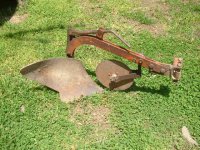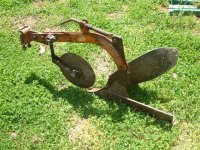ampsucker
Platinum Member
howdy, all!
not being around farm implements much, i wonder if some of you very handy folks would mind telling me what i have here. my uneducated mind tells me it might be a single bottom plow, but i'm not even sure about that. i read about folks who have middle busters, subsoilers, etc, but that doesn't mean much to me. hoping someone can help.
i'm also curious about pulling the thing. right now, the only way i could attach it is to my draw bar hitch or to a draw bar mounted on the 3-point. the way i'm seeing it, neither option would allow me to raise and lower it at the end of each row for turn around.
my understanding is the digging depth is controlled by a combination of the angle of the plow tip (crank handle), the guage wheel disk, and somewhat by speed. then, there is that piece of angle sticking off the back which may have something to do with it or maybe just keeps the thing tracking in the furrow?
is this just a cobbled together piece or is it pretty much as designed from the factory and how do you get the thing to lift at the end of each row without an upper link to the top three point attachment?
thanks for any help on identification and operation! here are the pics....
amp
not being around farm implements much, i wonder if some of you very handy folks would mind telling me what i have here. my uneducated mind tells me it might be a single bottom plow, but i'm not even sure about that. i read about folks who have middle busters, subsoilers, etc, but that doesn't mean much to me. hoping someone can help.
i'm also curious about pulling the thing. right now, the only way i could attach it is to my draw bar hitch or to a draw bar mounted on the 3-point. the way i'm seeing it, neither option would allow me to raise and lower it at the end of each row for turn around.
my understanding is the digging depth is controlled by a combination of the angle of the plow tip (crank handle), the guage wheel disk, and somewhat by speed. then, there is that piece of angle sticking off the back which may have something to do with it or maybe just keeps the thing tracking in the furrow?
is this just a cobbled together piece or is it pretty much as designed from the factory and how do you get the thing to lift at the end of each row without an upper link to the top three point attachment?
thanks for any help on identification and operation! here are the pics....
amp


